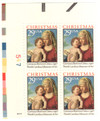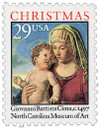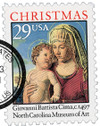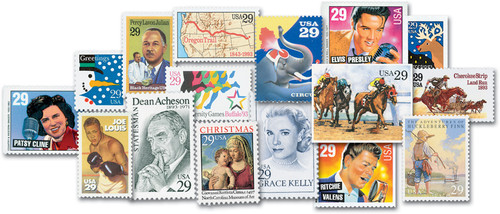
# 2789 - 1993 29c Traditional Christmas: Madonna and Child
US#2789
1993 Madonna and Child
- 1993 Traditional Christmas Stamp
- Produced in sheets and booklet panes
- Features 14th century Italian oil painting
Category of Stamp: Commemorative
Set: Christmas
Value: 29¢, First-Class mail rate
First Day of Issue: October 21, 1993
First Day City: Raleigh, North Carolina
Quantity Issued: 490,000,000
Printed by: Bureau of Engraving and Printing
Printing Method/Format: Offset and Intaglio, Panes of 50 (10 across, 5 down) from offset printing plate of 300 (15 across, 20 down) and intaglio printing sleeve of 600 (15 across, 40 down)
Perforations: 11 X 11
Reason the stamp was issued: The Madonna and Child stamp was issued for holiday mail sent in 1993.
About the stamp design: The 1993 Traditional Christmas stamp pictures a painting of Mary and the infant Jesus. The original work was done by Italian artist Giovanni Battista Cima de Conegliano, circa 1497 and was called Madonna and Child in a Landscape.
One of the world’s leading engravers, Thomas Hipschen, engraved the central portion of the stamp.
About the printing process: All parts of this stamp were engraved, while the booklet stamp was produced using a combination of engraving and offset lithography.
First Day City: The original painting used for the image on this stamp is housed at the North Carolina Museum of Art in Raleigh. The First Day of Issue ceremony was held in the museum’s auditorium before a standing-room-only crowd.
Unusual thing about this stamp: This stamp design was produced by two printing firms – Bureau of Engraving and Printing and KCS Industries. BEP produced the sheet stamps, while KCS Industries printed booklet stamps. The sheet stamps are slightly larger than the booklet stamps.
About the Christmas Stamps: By the early 1960s, the US Post Office was receiving 1,000 letters a year (for several years) asking for a Christmas-themed stamp to frank their holiday mail. The idea was approved and the US issued its first Christmas stamp on November 1, 1962.
The stamp was wildly popular, featuring popular holiday decorations of a wreath and candles. The Post Office Department had expected there would be a great demand for the issue, so they printed 350 million stamps – the largest print run for a special stamp up to that time. Those 350 million stamps sold out quickly, leading the Bureau of Engraving and Printing to produce more stamps – reaching over 860 million by the end of the year.
While the Christmas stamp was very popular, it wasn’t without its detractors. Some didn’t agree with the idea of the post office issuing a stamp honoring a religious holiday. Others wanted Christmas stamps that were more religious. The Post Office would continue to issue Christmas stamps in the coming years that featured the National Christmas Tree, seasonal plants, and an angel in 1965. The angel was considered less controversial because angels are included in many religions, not just Christianity.
In 1966, the Post Office came up with a plan to produce Christmas stamps utilizing classic paintings of the Madonna and Child. These stamps wouldn’t violate the separation of church and state because they were a celebration of culture. On November 1, 1966, they issued the first US Madonna and Child stamp in Christmas, Michigan. The stamp featured the 15th century painting, Madonna and Child with Angels, by Flemish painter Hans Memling.
That stamp was very popular and over 1.1 billion were printed. The same design was used again the following year, however, the 1967 stamp was larger and showed more of the painting. The stamp’s continued popularity led the Post Office to issue another traditional Christmas stamp in 1968, this time picturing the Angel Gabriel. For the 1969 issue, they reverted back to the non-religious theme, with a stamp picturing a painting called Winter Sunday in Norway, Maine.
The Post Office made a big change in 1970. To keep people in both camps happy, they issued one traditional Christmas stamp, picturing a classic painting of the Nativity, plus a block of four picturing Christmas toys. That decision proved popular and they have continued to issue stamps with both traditional and contemporary Christmas themes ever since.
History the stamp represents: Madonna and Child in a Landscape depicts Mary and baby Jesus with a monastery and a hill town in the landscape behind them. The artist, Cima, lived in Venice, often incorporated scenes from his hometown of Conegliano into the background of his paintings like he did in the artwork used for this stamp.
Born about 1459, Cima was part of the first generation of artists who ushered in the Golden Age of Venetian painting. This period was distinguished by three qualities: exploration and refinement of the oil medium, a remarkable sensitivity for rendering light, and a profound affinity for landscape painting - all very much apparent in his painting Madonna and Child in a Landscape.
Cima painted at least four other versions of Madonna and Child in a Landscape that differ only slightly from the painting at the North Carolina Museum of Art. The other versions are found in St. Petersburg, London, Italy, and Paris.
US#2789
1993 Madonna and Child
- 1993 Traditional Christmas Stamp
- Produced in sheets and booklet panes
- Features 14th century Italian oil painting
Category of Stamp: Commemorative
Set: Christmas
Value: 29¢, First-Class mail rate
First Day of Issue: October 21, 1993
First Day City: Raleigh, North Carolina
Quantity Issued: 490,000,000
Printed by: Bureau of Engraving and Printing
Printing Method/Format: Offset and Intaglio, Panes of 50 (10 across, 5 down) from offset printing plate of 300 (15 across, 20 down) and intaglio printing sleeve of 600 (15 across, 40 down)
Perforations: 11 X 11
Reason the stamp was issued: The Madonna and Child stamp was issued for holiday mail sent in 1993.
About the stamp design: The 1993 Traditional Christmas stamp pictures a painting of Mary and the infant Jesus. The original work was done by Italian artist Giovanni Battista Cima de Conegliano, circa 1497 and was called Madonna and Child in a Landscape.
One of the world’s leading engravers, Thomas Hipschen, engraved the central portion of the stamp.
About the printing process: All parts of this stamp were engraved, while the booklet stamp was produced using a combination of engraving and offset lithography.
First Day City: The original painting used for the image on this stamp is housed at the North Carolina Museum of Art in Raleigh. The First Day of Issue ceremony was held in the museum’s auditorium before a standing-room-only crowd.
Unusual thing about this stamp: This stamp design was produced by two printing firms – Bureau of Engraving and Printing and KCS Industries. BEP produced the sheet stamps, while KCS Industries printed booklet stamps. The sheet stamps are slightly larger than the booklet stamps.
About the Christmas Stamps: By the early 1960s, the US Post Office was receiving 1,000 letters a year (for several years) asking for a Christmas-themed stamp to frank their holiday mail. The idea was approved and the US issued its first Christmas stamp on November 1, 1962.
The stamp was wildly popular, featuring popular holiday decorations of a wreath and candles. The Post Office Department had expected there would be a great demand for the issue, so they printed 350 million stamps – the largest print run for a special stamp up to that time. Those 350 million stamps sold out quickly, leading the Bureau of Engraving and Printing to produce more stamps – reaching over 860 million by the end of the year.
While the Christmas stamp was very popular, it wasn’t without its detractors. Some didn’t agree with the idea of the post office issuing a stamp honoring a religious holiday. Others wanted Christmas stamps that were more religious. The Post Office would continue to issue Christmas stamps in the coming years that featured the National Christmas Tree, seasonal plants, and an angel in 1965. The angel was considered less controversial because angels are included in many religions, not just Christianity.
In 1966, the Post Office came up with a plan to produce Christmas stamps utilizing classic paintings of the Madonna and Child. These stamps wouldn’t violate the separation of church and state because they were a celebration of culture. On November 1, 1966, they issued the first US Madonna and Child stamp in Christmas, Michigan. The stamp featured the 15th century painting, Madonna and Child with Angels, by Flemish painter Hans Memling.
That stamp was very popular and over 1.1 billion were printed. The same design was used again the following year, however, the 1967 stamp was larger and showed more of the painting. The stamp’s continued popularity led the Post Office to issue another traditional Christmas stamp in 1968, this time picturing the Angel Gabriel. For the 1969 issue, they reverted back to the non-religious theme, with a stamp picturing a painting called Winter Sunday in Norway, Maine.
The Post Office made a big change in 1970. To keep people in both camps happy, they issued one traditional Christmas stamp, picturing a classic painting of the Nativity, plus a block of four picturing Christmas toys. That decision proved popular and they have continued to issue stamps with both traditional and contemporary Christmas themes ever since.
History the stamp represents: Madonna and Child in a Landscape depicts Mary and baby Jesus with a monastery and a hill town in the landscape behind them. The artist, Cima, lived in Venice, often incorporated scenes from his hometown of Conegliano into the background of his paintings like he did in the artwork used for this stamp.
Born about 1459, Cima was part of the first generation of artists who ushered in the Golden Age of Venetian painting. This period was distinguished by three qualities: exploration and refinement of the oil medium, a remarkable sensitivity for rendering light, and a profound affinity for landscape painting - all very much apparent in his painting Madonna and Child in a Landscape.
Cima painted at least four other versions of Madonna and Child in a Landscape that differ only slightly from the painting at the North Carolina Museum of Art. The other versions are found in St. Petersburg, London, Italy, and Paris.











